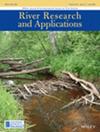地表淡水中溶解有机碳和总有机碳的现场测量:便携式现场测量仪的实验室验证
IF 1.9
4区 环境科学与生态学
Q4 ENVIRONMENTAL SCIENCES
引用次数: 0
摘要
淡水系统中的非生物有机物(包括有机碳)为食物网提供能量输入,并支持各种生态系统功能。在湿地、黑水河和溪流等水生生境中,可能会自然出现异常高的有机碳含量。然而,人为影响也可能导致有机碳含量偏高。近年来,人们观察到有机碳含量不断增加,并认为这是地表水棕色化和泡沫增加的驱动因素。由于取样物流和实验室测量所需的资源,总有机碳 (TOC) 和溶解有机碳 (DOC) 通常不包括在水生生态系统的实地研究中。作为实验室分析的潜在替代方法,我们通过比较实验室结果和现场收集的数据,评估了便携式现场测量仪的有效性。我们在西弗吉尼亚州北部的 43 个地表水点进行了比较。在每个地点,我们都使用 Real TOC/DOC 现场测量仪记录了现场测量结果,并收集和运送了水样,使用岛津 TOC-V 分析仪进行实验室测量。使用双变量分析和匹配对的一致性相关性对每个地点的实验室和实地数据进行了比较。实地测量与实验室测量之间的一致性较差,因此使用实验室获得的数据创建了一个新的数据模型,用于进一步比较。使用新的数据模型后,测量结果非常准确。这表明,真实 TOC/DOC 现场测量仪是现场测量水生生态系统中有机碳的可行仪器,可帮助监测和管理决策。本文章由计算机程序翻译,如有差异,请以英文原文为准。
In‐situ measurement of dissolved organic carbon and total organic carbon in fresh surface waters: Lab validation of a portable field meter
Nonliving organic matter, including organic carbon, in freshwater systems provides energy inputs to food webs and supports various ecosystem functions. Unusually high organic carbon levels can occur naturally in aquatic habitats such as wetlands and blackwater rivers and streams. However, values may also be high due to anthropogenic influences. In recent years, increasing levels of organic carbon have been observed and suggested as drivers of brownification and increased observation of foam on surface waters. Total organic carbon (TOC) and dissolved organic carbon (DOC) are not commonly included in field studies of aquatic ecosystems because of sampling logistics and resources required for laboratory measurement. As a potential alternative to laboratory analysis, we evaluated the effectiveness of a portable field meter by comparing laboratory results to data collected in situ. Comparisons were made at 43 surface water sites across northern West Virginia. At each of these sites, a field measurement was recorded using a Real TOC/DOC Field Meter, and a water sample was collected and transported for laboratory measurement using a Shimadzu TOC‐V analyzer. Data from the laboratory and field for each site were compared using bivariate analysis and concordance correlation on matched pairs. Poor agreement existed between field and lab measurements, so a novel data model was created using laboratory‐derived data for further comparison. Substantial accuracy was achieved using the new data model. This suggests that the Real TOC/DOC Field Meter is a viable instrument for field measurement of organic carbon in aquatic ecosystems and may aid in monitoring and management decisions.
求助全文
通过发布文献求助,成功后即可免费获取论文全文。
去求助
来源期刊

River Research and Applications
环境科学-环境科学
CiteScore
4.60
自引率
9.10%
发文量
158
审稿时长
6 months
期刊介绍:
River Research and Applications , previously published as Regulated Rivers: Research and Management (1987-2001), is an international journal dedicated to the promotion of basic and applied scientific research on rivers. The journal publishes original scientific and technical papers on biological, ecological, geomorphological, hydrological, engineering and geographical aspects related to rivers in both the developed and developing world. Papers showing how basic studies and new science can be of use in applied problems associated with river management, regulation and restoration are encouraged as is interdisciplinary research concerned directly or indirectly with river management problems.
 求助内容:
求助内容: 应助结果提醒方式:
应助结果提醒方式:


